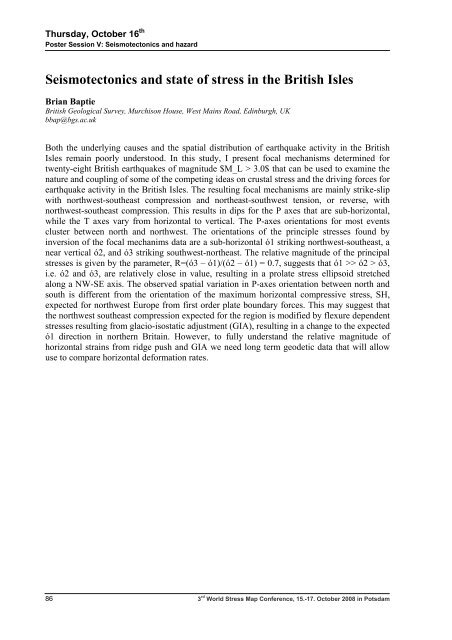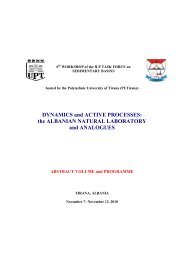World Stress Map Conference - International Lithosphere Program ...
World Stress Map Conference - International Lithosphere Program ...
World Stress Map Conference - International Lithosphere Program ...
Create successful ePaper yourself
Turn your PDF publications into a flip-book with our unique Google optimized e-Paper software.
Thursday, October 16 th<br />
Poster Session V: Seismotectonics and hazard<br />
Seismotectonics and state of stress in the British Isles<br />
Brian Baptie<br />
British Geological Survey, Murchison House, West Mains Road, Edinburgh, UK<br />
bbap@bgs.ac.uk<br />
Both the underlying causes and the spatial distribution of earthquake activity in the British<br />
Isles remain poorly understood. In this study, I present focal mechanisms determined for<br />
twenty-eight British earthquakes of magnitude $M_L > 3.0$ that can be used to examine the<br />
nature and coupling of some of the competing ideas on crustal stress and the driving forces for<br />
earthquake activity in the British Isles. The resulting focal mechanisms are mainly strike-slip<br />
with northwest-southeast compression and northeast-southwest tension, or reverse, with<br />
northwest-southeast compression. This results in dips for the P axes that are sub-horizontal,<br />
while the T axes vary from horizontal to vertical. The P-axes orientations for most events<br />
cluster between north and northwest. The orientations of the principle stresses found by<br />
inversion of the focal mechanims data are a sub-horizontal ó1 striking northwest-southeast, a<br />
near vertical ó2, and ó3 striking southwest-northeast. The relative magnitude of the principal<br />
stresses is given by the parameter, R=(ó3 – ó1)/(ó2 – ó1) = 0.7, suggests that ó1 >> ó2 > ó3,<br />
i.e. ó2 and ó3, are relatively close in value, resulting in a prolate stress ellipsoid stretched<br />
along a NW-SE axis. The observed spatial variation in P-axes orientation between north and<br />
south is different from the orientation of the maximum horizontal compressive stress, SH,<br />
expected for northwest Europe from first order plate boundary forces. This may suggest that<br />
the northwest southeast compression expected for the region is modified by flexure dependent<br />
stresses resulting from glacio-isostatic adjustment (GIA), resulting in a change to the expected<br />
ó1 direction in northern Britain. However, to fully understand the relative magnitude of<br />
horizontal strains from ridge push and GIA we need long term geodetic data that will allow<br />
use to compare horizontal deformation rates.<br />
86 3 rd <strong>World</strong> <strong>Stress</strong> <strong>Map</strong> <strong>Conference</strong>, 15.-17. October 2008 in Potsdam




